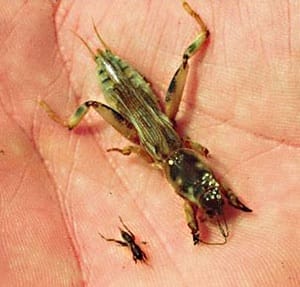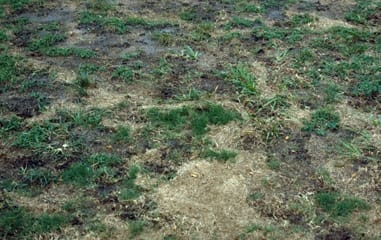 Late June through early July is a good time to treat for mole crickets in turf.
Late June through early July is a good time to treat for mole crickets in turf.
How do you know if a lawn has mole crickets?
Unfortunately, it is easier to scout for mole cricket injury earlier in the year. Mole crickets themselves are small and very hard to see in June and July.
 Mole crickets tunnel underground, killing roots by feeding and tunneling and also come up to eat the leaves. Attacked grass begins to thin and then disappear. The ground will be softened as the soil is pulverized by the tunneling of the crickets. On bare ground you should see the tunnels, especially a day or so after a rain. Golf course managers can watch for the presence of mole crickets by looking for tunnels in sand traps.
Mole crickets tunnel underground, killing roots by feeding and tunneling and also come up to eat the leaves. Attacked grass begins to thin and then disappear. The ground will be softened as the soil is pulverized by the tunneling of the crickets. On bare ground you should see the tunnels, especially a day or so after a rain. Golf course managers can watch for the presence of mole crickets by looking for tunnels in sand traps.
Landscapers and home owners may mistake earthworm castings for mole cricket injury. Earthworms leave piles of granulated soil while mole crickets leave tunnels. Even dying grass is not proof you have mole crickets. Look for the small tunnels and thinning grass.
Use a soap drench to drive mole crickets to the surface where you can see them.
Prior to drenching, the soil should be moist. Irrigate 24 hours before drenching if the soil is dry. Mix one-half to one ounce of dishwashing detergent in a gallon of water. Soak the soil well in affected areas. Mole crickets should come to the surface within a few minutes.
Mole crickets have one generation a year. The adults fly, mate and lay eggs March through early June. Eggs generally hatch in May and June.
Mole crickets are generally younger and smaller in late June and July and much easier to kill.
Areas with signs of adult mole cricket activity in April and May are most likely to have nymphs in July.
Not all turf needs to be treated for mole crickets.
Consider treating turf that has a history of mole cricket problems. Athletic fields that keep their lights on during May and June can be at greater risk because the lights attract the adults.
Dr. Will Hudson’s publication on mole crickets has some great control information and photos.
For pesticide recommendations, see the Pesticide Management Handbook or contact your local Extension agent.
Early treatment is important.
Mole cricket nymphs are small and easy to control in late June and early July. As these insects get larger they will require more chemical and more applications for control. Later chemical treatments may be less effective giving a lower kill rate. As the mole crickets get larger, they also do more damage to turf.
When using insecticides, you can increase control of mole crickets by allowing the soil to dry out for 3 or 4 days and then irrigate thoroughly in the evening. Apply the insecticide the next afternoon. Mole crickets are sensitive to soil moisture and will move down in the ground to find comfortable conditions if the surface is dry. Irrigation will bring them back up to resume feeding the following night, making them easier targets for control.
Remember
Timely treatment is the key to good mole cricket control. Read and follow all label recommendations when using any pesticide.
For more information:
Pest Management Handbook (Follow all label recommendations when using any pesticide)
